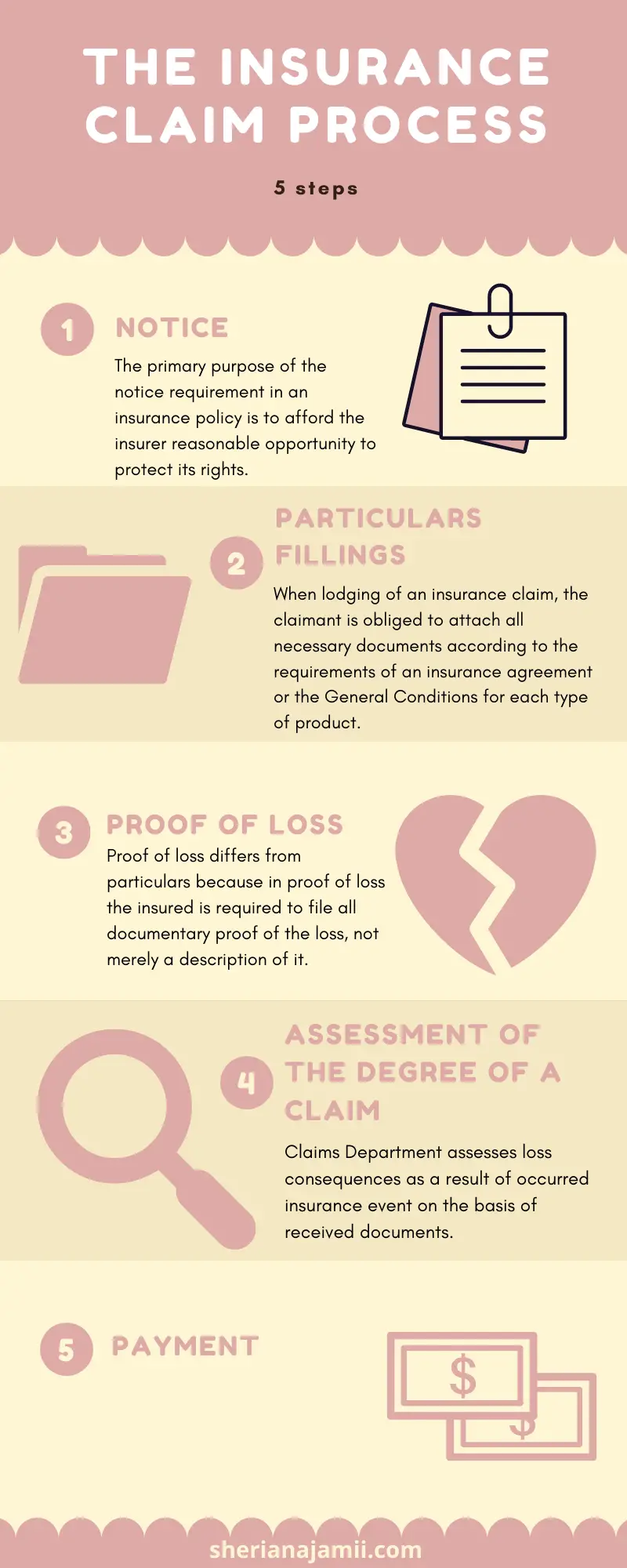
Ready to Master the Art of Persuasive Communication? Unlock Your Success Today!

Here you will learn must-six steps involved in the insurance claim procedure.
The insurance claim procedure and management is the core issue for the protection of insurance policyholders.
Insurance contracts always contain a provision that provides for a specific process to be followed or actions to be taken in the course of reporting a loss or event and presenting a claim to the insurance company.
In the process, management, and extent of handling insurance claims there are key obligations to be observed to ensure that the principles of the contract of insurance and all fundamental elements of insurance are adhered to by both insurers and the insured in the whole process of indemnity.
The focus here is to share with you the whole insurance claim process.
Transform Your Communication, Elevate Your Career!
Ready to take your professional communication skills to new heights? Dive into the world of persuasive business correspondence with my latest book, “From Pen to Profit: The Ultimate Guide to Crafting Persuasive Business Correspondence.”

What You’ll Gain:
An insurance Claim refers to the formal application/request by an insured person technically known as the policyholder to an insurance company for the compensation of loss or event which is covered under the relevant insurance policy.
When you suffers a loss that is covered by your insurance policy, you can file an insurance claim with the insurance company to obtain payment.
For instance, if a fire damages a your insured property you will submit a claim to start the process of the insurance provider paying for the repairs.
Insurance claims can be filed for a variety of reasons, including property damage, injuries sustained in auto accidents, yearly physicals, and life insurance death benefits.
Depending on the nature and scope of your claim, the payment process may take a few weeks to a few years.
Claim filing has become more simpler, and many businesses now provide the option to do it online, using an app, or by phone with an agent.
You can learn different types of insurance claims from Investopedia.
As a general rule, the major factors to be taken into consideration in the whole process and the extent of handling insurance claims must be stipulated in insurance policies.
Those factors include provisions relating to the timeline of actions by a claimant following the occurrence of an insured event.
In the absence of those provisions, the policyholder is required to act in good faith.
Insurance claims can be filed for a variety of reasons, including property damage, injuries sustained in auto accidents, yearly physicals, and life insurance death benefits.
Depending on the nature and scope of your claim, the payment process may take a few weeks to a few years.
The following are the 6 Steps in the Insurance Claim Procedure

This is the first and basic obligation as far as the procedures of an Insurance claim.
If the policy is a third-party policy, the condition may well require that notice be given of any event that is likely to give rise to a claim against the insured in addition to an actual claim.
The primary purpose of the notice requirement in an insurance policy is to afford the insurer a reasonable opportunity to protect its rights.
When liability coverage is involved, the insurance policy always states that the insured must notify an insurer about the events that are the basis of a subsequent claim.
If the policy is a third-party policy, the condition may well require that notice be given of any event that is likely to give rise to the claim against the insured in addition to the actual claim.
Yes. Oral notice is sufficient unless the insurance policy provides otherwise.
See:
The time to issue a notice to the insurance company must be reasonable. This means the insured is expected to give notice as soon as possible taking all the circumstances of the loss or event.
Another condition as to notice may require that it is given to a particular place, for example, Insurer’s head office. Failure to deliver notice to an appropriate place may render it invalid.
Another process to be undertaken in insurance claims is filling particulars.
When lodging an insurance claim, the claimant is obliged to attach all necessary documents according to the requirements of an insurance agreement or the General Conditions for each type of product.
The necessary document might be attached including the Original insurance policy or original insurance membership certificate in cases of group, policy, with which the claimant proves their right to lodge a claim; All annexes to the original insurance contract if any.
This is another process. In an insurance contract, a condition may also require the insured to provide proof of his loss.
Proof of loss differs from particulars because in proof of loss the insured is required to file all documentary proof of the loss, not merely a description of it.
Sometimes the insured will be required to make a statutory declaration.
Even though the proofs may plainly show (prima facie) that the loss is covered by the policy, the burden of proving this, should the matter be litigated, still rests upon the insured.
After the insured presents particulars, and proof of loss, the insurer prepares the basis for assessment of the claim, grounds, and procedures for defining the payment on the basis of a collected required document as shown above.
Claims Department assesses loss consequences as a result of occurred insurance events on the basis of received documents.
The amount of insurance payment depends on the definitions and procedures as specified in the insurance contract or General Condition by type of product and per type of risk covered.
In case of an insurable event, a sum insured will be paid as it was defined at the inception of insurance cover. It might be a lump sum or part of it.
The Insurer has the right to subtract all non-paid premiums from the insurance payment as well as any taxes or legal obligations that the Insurer is obliged to subtract by law.
This is the last step. The Insurer will take one of the following decisions after receiving all necessary documents required or additional documents required by the Insurer:
The insurer may decide to accept a claim as a valid one or to refuse to pay a claim.
The notification for payment must indicate if the insurance payment is a lump sum and if this terminates the insurance coverage.
The claim is payable in the original currency of the risk the currency of the sum insured and premiums payable unless the insured person wishes to receive other clarification.
Notification about refusal concludes all data for identification of a claim number of the claim, date of occurrence of the insured event, etc. as well as the reason for refusal of payment.
Is your claim denied?
Read: How to appeal against an insurance decision
All the insurance complaints must be submitted at the headquarters of the Insurer.
A complaint must be written in plain language and contain the following minimum information: the name of the claimant, address of the person as well as the telephone number for contacting them, reasons for the complaint, the signature of the claimant, and date of submission of the complaint.
Insurance claims have been one the substantial problems especially when an insurance company or insurers become reluctant in indemnifying the insured in an Insurance policy contract.
Thus, generally, the process of lodging insurance claims depends on the nature of the insurance policy, insurance contract, and property insured against certain peril, as to how the insurance company sets forth the rules and the procedure of lodging the claims.
In case you have an insurance claim or complaint you may find a good Insurance claim lawyer near you for more help.
See also: Meaning of Life insurance and Types of Life insurance policy
Birds. J. (2007) Modern Insurance Law, 7th Ed, Sweet and Maxwell Ltd, London.
Keeton .R. E & Widiss .A.I (1988) Insurance Law, Practitioners Edition, West Publishing Co Ltd.USA.
N.A.Saleemi (1999), Commercial Law Simplified, N.A. Saleemi Publishers, Nairobi, Kenya.